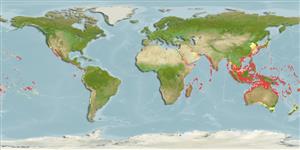Common names from other countries
Environment: milieu / climate zone / depth range / distribution range
বাস্তুসংস্থান
; গভীরতার পরিসীমা 2 - 71 m (Ref. 101222). Tropical
Indo-Pacific.
Length at first maturity / আকৃতি / ওজন / Age
Maturity: Lm ? range ? - ? cm Max length : 50.0 cm TL পুরুষ/ লিঙ্গ অনিধর্ারিত ; (Ref. 822); common length : 12.0 cm BASL পুরুষ/ লিঙ্গ অনিধর্ারিত ; (Ref. 349); সবের্াচ্চ প্রকাশিত ওজন : 500.00 g (Ref. 2594)
Common among seaweeds and grass flats in shallow water environments, especially in sheltered bays and lagoons (Ref. 349). Found during the day under rocks and at night crawling around reef flats and seagrass beds (Ref. 844). Inhabits eel grass beds, reef flats, or tidal swimming pools (Ref. 866). Nocturnal (Ref. 822).
Life cycle and mating behavior
পরিপক্কতা | প্রজনন | ডিম ছাড়া | ডিমসমূহ | ডিম্বধারন ক্ষমতা | শুককীট
Members of the order Anaspidea are mostly simultaneous hermaphrodites.
Poutiers, J.M. 1998. (Ref. 349)
IUCN Red List Status (Ref. 130435)
CITES status (Ref. 108899)
Not Evaluated
Not Evaluated
Threat to humans
Harmless
Human uses
| FishSource |
হাতিয়ার
আরো তথ্য
Age/Sizeবৃদ্ধিLength-weightLength-lengthবহিঃ অঙ্গ সংস্থানশুককীট প্রাচুর্য
ইন্টারনেট সুত্র
Estimates based on models
Preferred temperature
(Ref.
115969): 22.6 - 29.1, mean 28 (based on 1616 cells).
স্থিতিস্থাপক
উচ্চ, সর্বনিম্ন প্রজন দ্বিগুনের সময় ১৫ মাস (K=0.8-1).
Vulnerability
Moderate vulnerability (40 of 100).
Price category
Unknown.
